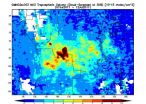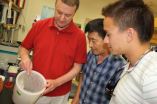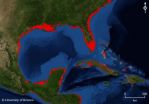(Press-News.org) The eye of a tropical cyclone is an indication of a strong storm, and Typhoon Ma-on's eye was apparent in visible and infrared imagery captured by NASA's Aqua satellite. Ma-on just achieved Category Four status on the Saffir-Simpson scale that measures hurricane intensity.
The Moderate Resolution Imaging Spectroradiometer (MODIS) instrument that flies aboard NASA's Aqua satellite took an image of Typhoon Ma-on that clearly shows the storm's eye, although it has some high clouds in it. The image was taken at 04:15 UTC (12:15 a.m. EDT) on July 15 as Typhoon Ma-on continues moving west in the western Pacific Ocean.
When NASA's Aqua satellite passed over Ma-on on July 14 at 03:23 UTC, the Atmospheric Infrared Sounder (AIRS) instrument captured an infrared image of the storm. The infrared image showed a large area of coldest cloud tops and the strongest thunderstorms mostly south of the center of circulation, and also revealed an eye at that time.
On July 15 at 0900 UTC (5 a.m. EDT), Typhoon Ma-on's winds were stronger than they were the day before. Maximum sustained winds are now at 115 knots (132 mph/213 kmh). Ma-on is located about 250 nautical miles south of Iwo To, Japan near 20.7 North and 140.9 East.
The strongest thunderstorms in Ma-on are still located south of the center of circulation. Visible, microwave and infrared imagery all show a well-defined eye within the storm.
Ma-on is moving to the west-northwest along the southern edge of a subtropical ridge (elongated area) of high pressure. This weekend people on Iwo To, Chici Jima and Kadena Air Base can experience rough seas and gusty winds and rains.
Ma-on is then expected to move to the north, then northeast as it curves around the western edge of the ridge. That would put Ma-on on track to skirt the eastern edge of the big island of Japan early next week.
INFORMATION:
Typhoon Ma-on's eye seen in NASA satellite Images
2011-07-19
ELSE PRESS RELEASES FROM THIS DATE:
NASA's Aura satellite measures pollution 'butterfly' from fires in central Africa
2011-07-19
Fires raging in central Africa are generating a high amount of pollution that is showing up in data from NASA's Aura Satellite, with the ominous shape of a dark red butterfly in the skies over southern part of the Democratic Republic of the Congo and northern Angola.
An image of the pollution from agricultural fires in central Africa was created from data of nitrogen dioxide (NO2) levels over the period from July 7 to 12, 2011. It was created from Ozone Measuring Instrument (OMI) data using the NASA Giovanni system by Dr. James Acker at NASA's Goddard Space Flight Center ...
Nursing home residents at heightened risk of falling in the days following
2011-07-19
BOSTON—Nursing home residents taking certain antidepressant medications are at an increased risk of falling in the days following the start of a new prescription or a dose increase of their current drug, according to a new study by the Institute for Aging Research of Hebrew SeniorLife, an affiliate of Harvard Medical School.
Published online in the Journal of Gerontology: Medical Sciences, the study found that nursing home residents have a fivefold increased risk of falling within two days of a new prescription for or an increased dose of a non-SSRI (selective serotonin ...
New health-care payment system slows spending while improving patient care
2011-07-19
In a new study with implications for state and federal efforts to reform payments to doctors and hospitals to encourage greater coordination of care, Harvard Medical School researchers found that a global payment system underway in Massachusetts lowered medical spending while improving the quality of patient care relative to the traditional fee-for-service system.
The study, published today in the New England Journal of Medicine, examined the Alternative Quality Contract (AQC), which was first introduced by Blue Cross Blue Shield of Massachusetts (BCBSMA) in 2009 and ...
World's forests' role in carbon storage immense, profound
2011-07-19
Fairbanks, Alaska—Until now, scientists were uncertain about how much and where in the world terrestrial carbon is being stored. In the July 14 issue of Science Express, scientists report that, between 1990 and 2007, the world's forests stored about 2.4 gigatons of carbon per year.
Their results suggest that forests account for nearly all of the world's land-based carbon uptake. Boreal forests are estimated to be responsible for 22 percent of the carbon stored in the forests. A warming climate has the potential to increase fires and insect damage in the boreal forest ...
Scientists seek to increase science literacy
2011-07-19
Fairbanks, Alaska—A scientist at the University of Alaska Fairbanks and colleague at Emory University are seeking to persuade the National Science Foundation to reevaluate its decision to cancel a program that has placed 10,000 science graduate students in more than 6,000 K-12 public schools across the country.
In an editorial in the July 15 issue of the journal Science, UAF biology professor Richard Boone and Emory University professor Pat Marsteller advocate for developing an enhanced version of NSF's Graduate Science, Technology, Engineering and Mathematics Fellows ...
Making blood-sucking deadly for mosquitoes
2011-07-19
Mosquitoes die soon after a blood meal if certain protein components are experimentally disrupted, a team of biochemists at the University of Arizona has discovered.
The approach could be used as an additional strategy in the worldwide effort to curb mosquito-borne diseases like dengue fever, yellow fever and malaria.
When the researchers blocked a cellular process known as vesicle transport, on which the mosquitoes rely to release digestive enzymes into the gut among other functions, it caused the affected animals to die within two days of blood feeding.
"The idea ...
Rising oceans -- too late to turn the tide?
2011-07-19
Thermal expansion of seawater contributed only slightly to rising sea levels compared to melting ice sheets during the Last Interglacial Period, a University of Arizona-led team of researchers has found.
The study combined paleoclimate records with computer simulations of atmosphere-ocean interactions and the team's co-authored paper is accepted for publication in Geophysical Research Letters.
As the world's climate becomes warmer due to increased greenhouse gases in the atmosphere, sea levels are expected to rise by up to three feet by the end of this century.
But ...
NYU Langone Medical Center's tip sheet to the 2011 Alzheimer's Association International Conference
2011-07-19
NEW YORK, July 16, 2011 – Experts from the Center of Excellence on Brain Aging at NYU Langone Medical Center will present new research at the 2011 Alzheimer's Association International Conference on Alzheimer's disease to be held in Paris, France from July 16 – 21. Of particular interest is the presentation about mild cognitive impairment in retired football players, with Stella Karantzoulis, PhD, and the selected "Hot Topics" presentation about a new experimental approach to targeting amyloid plaques, with Fernando Goni, PhD. Each presentation is embargoed as noted below.
The ...
Newer techniques are making cardiac CT safer for children
2011-07-19
Coronary computed tomography angiography (CTA) has excellent image quality and diagnostic confidence for the entire spectrum of pediatric patients, with significant reduction of risk with recent technological advancements, according to a study to be presented at the Sixth Annual Scientific Meeting of the Society of Cardiovascular Computed Tomography (SCCT) in Denver, July 14-17.
"Traditionally, pediatric patients who require coronary artery imaging have undergone a cardiac catheterization, which is an invasive procedure with a significant radiation dose, requiring sedation ...
NYU researchers develop compound to block signaling of cancer-causing protein
2011-07-19
Researchers at New York University's Department of Chemistry and NYU Langone Medical Center have developed a compound that blocks signaling from a protein implicated in many types of cancer. The compound is described in the latest issue of the journal Nature Chemical Biology.
The researchers examined signaling by receptor tyrosine kinase (RTK). Abnormal RTK signaling is a major underlying cause of various developmental disorders and diseases, including many forms of cancer. RTK signaling pathway employs interactions between proteins Sos and Ras, and accounts for a broad ...



